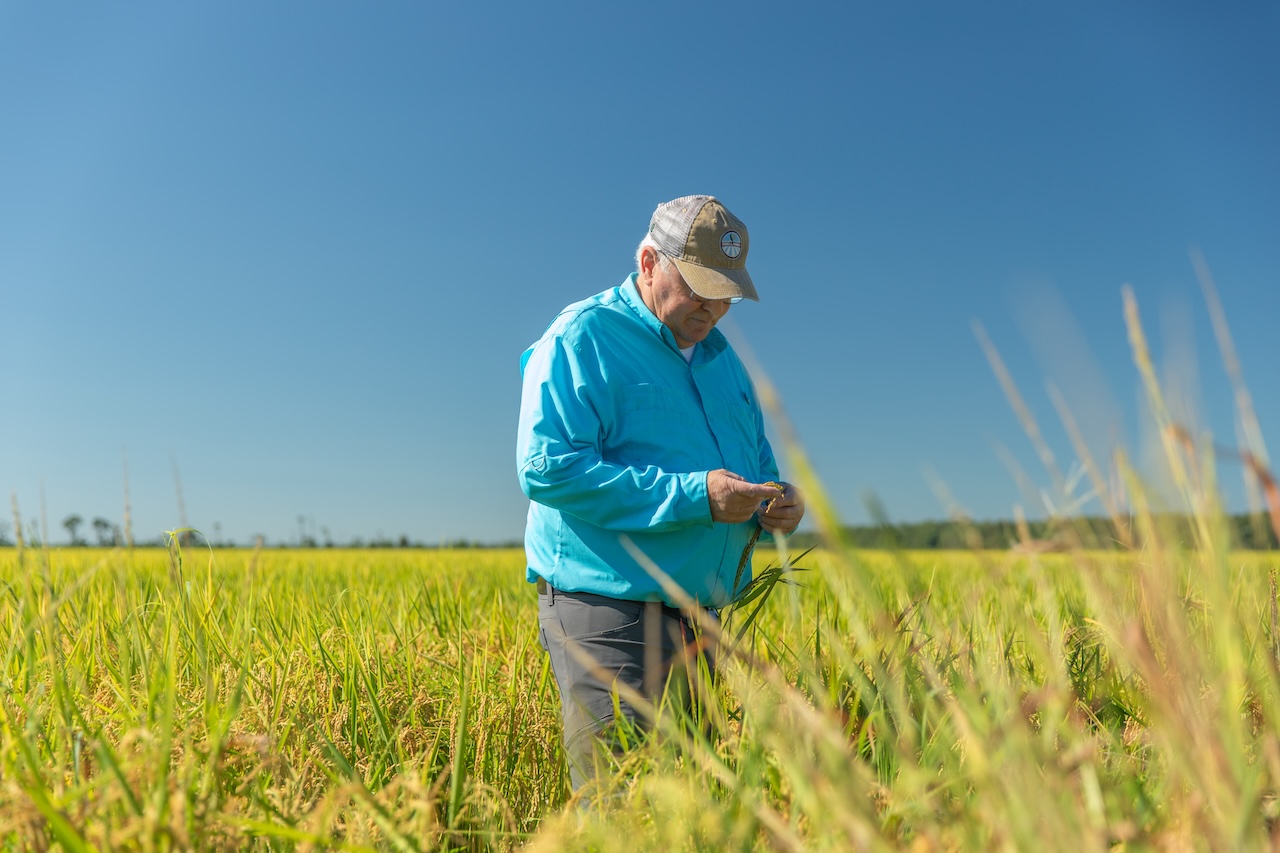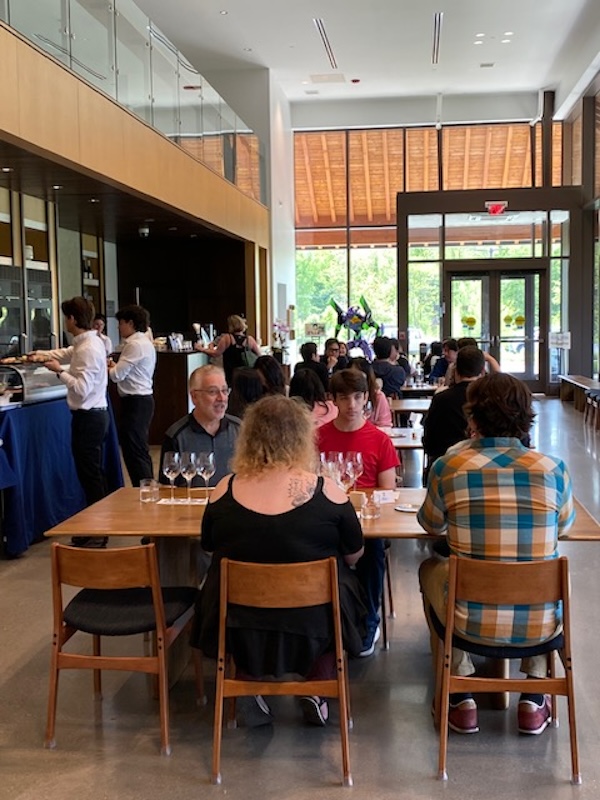This Month’s Featured Article

Dassai Blue is Sake Gold
It was a beautiful day for a scenic drive from Troy to Hyde Park, through Rensselaer and Columbia Counties into Dutchess County. I was traveling with a special friend, sun roof open, soaking up the sunshine and gasping at how green everything was for mid-May. All was right with the world on that sunny Sunday.
It was no surprise, then, that the first impression of the Dassai Blue Sake Brewery off Route 9, almost across the street from the venerable Culinary Institute of America, had a very high wow factor. Fully exposed at noon on that blue-sky Sunday, everything about the facility radiated beauty, focus, and reverence. And that was from the outside. I was excited to learn about this new and unique sake brewery that opened in October of 2023, and the majesty of the day and the moment was the perfect backdrop.
We were booked on the noon tour and tasting, so we were among the first visitors to Dassai Blue that day. While we waited for the tour to begin, we admired the expansive and welcoming main hallway that included a gallery space leading to the tasting room, in which tables were set with wine glasses and flowers and menus more in keeping with a dinner party than a bar. A sushi chef was preparing the dishes that would accompany the tasting.
At noon we were invited to gather for the tour. Interestingly, the other visitors were Japanese, and most of them spoke only halting English. This contributed to the feeling of being in a very special space. Phaedra was our guide, and by the time we finished, I had a deep appreciation for not just the production of sake, but the art of it and the passion that Dassai has brought to it over generations.
An opportunity to expand and share
Hiroshi Sakurai is the chairman of the company that produces Dassai, Asahi Shuzo. He inherited the family sake business in 1984, and his son, Kazuhiro Sakurai, is now a fourth-generation president of the company. Sake is becoming increasingly popular around the world, and they were both astonished that its consumption was so low in the United States. The Sakurais recognized a very real opportunity to engage Americans with premium sake, and they decided to build a brewery in this country.
The selection of Hyde Park, NY, as the site of the Dassai Blue Sake Brewery was as deliberate as everything else that goes into the production of Dassai and Dassai Blue. Hiroshi Sakurai understood the value of the Culinary Institute of America to what could be possible for Dassai Blue. In 2016, the CIA launched an advanced Japanese cuisine initiative with a bachelor’s degree concentration in Japanese cuisine. Having Dassai Blue next door is not only a great way for students in the program to have the opportunity to work there and be immersed in this very important part of Japanese cuisine and culture but also for visitors to Dassai Blue to enjoy the same elevated experience around the appreciation of this culinary art as they have at the CIA’s restaurants.
Another important consideration for Hyde Park? Hudson Valley water. Water is a critical ingredient for sake (and any craft beverage), and the mineral content can greatly affect how the fermentation goes and, in turn, the flavor. The water in the Hudson Valley is naturally rich in the minerals that make for excellent sake. The decision was made: Dassai Blue Sake Brewery’s home is in Hyde Park, NY. The facility is 650,000 square feet and cost $80 million, which included the brewery, the water treatment facility, and the rice polishing building. It is another real gem in the Valley.
Why Dassai Blue and not just Dassai as in Japan? “The goal of Dassai Blue,” according to the company, “is to brew a more superior product than our sake in Japan. We look to the proverb about the indigo plant. The dye possesses a deeper hue of blue than the very indigo plant from which it originates, symbolizing the transformative power of art and craftsmanship to elevate and enrich the natural world’s inherent beauty.” It is this attention to craft and quality that inhabit the Dassai Blue Sake Brewery – right here in our backyard! – and they are ready for visitors.
Jocelyn Heyward is Dassai Blue’s senior brand manager. “Since Dassai Blue’s opening in October 2023,” she says, “we have been excited to share with the community and the public what we are about. The care and craftsmanship that go into every part of the production of the sake here shines through in our offerings,” she says, brimming with enthusiasm and pride. And there we were, my friend and I, ready for the experience.
What is your relationship with sake?
One of the first questions Phaedra asked before we started the tour was how familiar we were with sake in general. While plenty of people are sake enthusiasts, many others, like me, have only the vaguest notion of what it’s about and why. I know that it’s made from rice, that it comes in different styles and even flavors, and that it’s typically served chilled, but my experience with it has been to drink it warm at a sushi restaurant (which I have always enjoyed). Little did I know what I’ve been missing all these years!
How is sake made, and how are sakes different from each other? Phaedra did an excellent job of explaining the Dassai Blue process to us, noting that underlying all the actions is the Japanese concept of “tema” – hard work and effort put in by human touch. At Dassai Blue, nothing is automated. All the work is done in smaller batches, with the focus on exceptional flavor.
The essence of sake
Sake is made from four ingredients: rice, water, koji, and yeast.
The rice
Many different kinds of rice can be used to make sake. Dassai uses Yamada Nishiki rice, known in sake circles as the “king” of rice for the gentle and delicate flavors it yields. Another characteristic of Yamada Nishiki rice is that it can be difficult to grow. It has long stems that make it prone to falling over in the wind. It takes farmers with real expertise to let the king of sake rice reign. When it knew it would be making its home in the United States, Dassai Blue immediately looked for a partner to grow the Yamada Nishiki. It found Isbell Farms in Arkansas – a multigenerational family farm focusing on sustainable production, exported seeds from Japan, and spent four years working with the Isbells to cultivate the rice.
The rice arrives from Arkansas as whole grains. It is polished at the brewery in Hyde Park. Polishing removes the outer layers to get to the heart of the grain – the “shinpaku” – which is the concentrated starch. Rice is polished to certain percentages – called “rice polishing ratios.” The lower the ratio, the more concentrated the heart of the grain, and therefore the more flavor the sake will have.
Sake labels are classified based on the rice-polishing ratio. Sake made with rice polished to 50% or lower is classified as Daiginjo. The highest classification is Junmai Daiginjo, which means the RPR is 50% or less, and there are no additives beyond rice, water, koji, and yeast. Dassai in Japan and Dassai Blue here in Hyde Park produce only Junmai Daiginjo.
For Junmai Daiginjo sake, rice must be polished to a minimum of 50% – the lower the percentage, the higher the quality. Dassai Blue makes a Junmai Daiginjo 50, a 35, and a 23.
In the brewery, as this is explained, there are samples of the grains to see and feel, from whole grain to 50% to 23%. It’s critical that the polishing process be gentle, as the goal is to get the whole shinpaku and not just broken grains. Phaedra explains that the polishing is done with forced air and stones that bounce the grains over and over to polish them to the desired percentage.
With the grains at the desired percentages, the rice is rinsed, then soaked, then steamed, all working in small batches at the proper temperatures in controlled environments. The steamed rice is laid out on cloth-covered tables made of Japanese cedar.
The koji
Koji is the national fungus of Japan – who knew?! It’s a strain of Aspergillus oryzae, which is used in various culinary practices, including miso and soy sauce. It contains enzymes that transform starches and proteins into amino acids and sugars. In sake production, it essentially kickstarts fermentation when applied to steamed rice.
Phaedra told us that the Japanese have a reverence for koji and what it does, and the room in which the koji is made and then applied to the rice is called the Koji Moru; she called it a “sacred space.” When it’s time to apply the koji, the brewers walk along the cedar tables where the rice is laid out and, in unison, take the same steps and shake the koji applicators at the same time and in the same way. It’s done in small batches, with everything controlled and monitored. Koji helps convert the starches in the rice to sugars.
The yeast
Yeast is essential for the production of all alcoholic beverages. It “eats” the sugar, converting it into alcohol and carbon dioxide. Yeast also contributes flavors to the sake, most notably those around floral and fruit notes.

Fermentation and finishing
With the rice, water, koji, and yeast playing their roles, the sake undergoes fermentation during which time it is stirred twice a day, every day. It’s another low and slow process in a strictly temperature-controlled environment. There are 52 tanks in the fermentation room. Each has the capacity to produce 4,500 bottles. This sounds like a lot, but Phaedra points out that it’s about five times smaller than a typical sake brewery. The fermenting rice is stirred carefully every day for about 35 days at a constant temperature of 41 degrees Fahrenheit. At this stage, the sake is called a moromi mash. We were brought a sample to taste. It’s opaque and slightly effervescent with lots of delicate floral and umami notes. What a treat!
After fermentation, the rice is pressed so that the liquid is retrieved from the solids. That liquid is the sake. When it’s time to bottle, the filtered sake is put into sterilized bottles, which are then pasteurized. Currently, Dassai Blue is making Type 23, Type 35, and Type 50 Junmai Daiginjos as well as a Nigori Sparkling – in-bottle secondary fermentation of the Type 50 without any added sugar.
Kanpai! (Cheers!)
With the tour of the production areas complete, we were welcomed to our tasting. At a table set with three spotless glasses on a sheet explaining which sake was in each, and a printed menu of the sushi we would be served to eat with it, we settled in to taste the Dassai Blue Types 23, 35, and 50. The staff in the tasting room was as polished and lovely as the rest of the brewery. We learned that Ashby and Judson were students at the CIA who were also cousins, and whose fathers had both gone to the CIA and owned restaurants in Houston, Texas, where they would be headed back when they graduated. In the meantime, they were keen on learning everything that makes Dassai Blue so special, including the thoughtful presentation that’s so important to Japanese hospitality. Briana, another server, and a Hudson Valley native, was at Dassai Blue because she loved introducing people to the sake and learning what brought them there. She shone a knowing smile when we exclaimed how delicious the sushi was and how beautiful the sakes were.
“At Dassai Blue,” Jocelyn Heyward says, “education is very important. The rice polishing ratio numbers are front and center to sell the product, so it’s important for people to understand what they mean and why. The flavors are very important,” she continues, “the sakes are served in wine glasses for the tastings, which best open them up and contribute to the aromatic experience.”
Jocelyn herself was new to sake when she started working with Dassai Blue about a year ago, so she, too, has come to understand the “tema” involved in bringing the sake to people who haven’t experienced anything like it before. Her favorite thing? “When I’m in the tasting room and I see the mix of people visiting and their different ways of knowing sake or not, and they say, ‘Wow, I wasn’t expecting that!’”
If she’d been at our table she would have heard those very words being spoken by my friend. He almost didn’t join me on the trip because he had tried several sakes and never really liked them. Dassai Blue? “Wow, I wasn’t expecting that,” he said as we enjoyed the beautiful aromatics, smooth mouthfeel, and delicate notes ranging from stone fruit to honeysuckle to lemon curd and so much more in each of the sakes. Another stand-out quality we noted was how very clean the sakes tasted. “I like these a lot,” he said, surprising himself the most. I, too, thought they were all fantastic and nothing like I’d ever tasted before.
Sake and potato chips
Another thing we learned is how versatile sake can be with food. While sushi was a delightful and appropriate pairing with all the sakes, Dassai Blue also offers a charcuterie board to accompany a tasting. “Soon we’ll be offering foods made at the Culinary Institute to pair with sake tastings on any day of the week,” Jocelyn says, “and the sushi will be available on Saturdays and Sundays. I like caviar and potato chips with the Type 50,” Jocelyn confesses. Sounds good to me!
I can’t recommend highly enough a visit to Dassai Blue to do the tour and tasting. The very fact that the brewery is here in the Hudson Valley is amazing. Dassai Blue hosts events throughout New York state, too, including New York City. The sakes are on the menus at the Culinary Institute restaurants, as well, and they are distributed at wine and liquor stores throughout New York and soon other states, as well.
On June 18, I learned that Dassai Blue won First Place (Gold Medal) in the Overseas Sake category at the Sake Competition 2024. Congrats! Follow Dassai Blue Sake Brewery on social media, and learn more at dassai.com.


